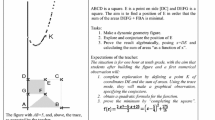Abstract
The paper starts from classroom situations about the study of a functional relationship with help of technological tools as a ‘transposition’ of experimental approaches from research mathematical practices. It considers the limitation of this transposition in existing curricula and practices based on the use of non-symbolic software like dynamic geometry and spreadsheets. The paper focuses then on the potentialities of classroom use of computer algebra packages that could help to go beyond this shortcoming. It looks at a contradiction: while symbolic calculation is a basic tool for mathematicians, curricula and teachers are very cautious regarding their use by students. The rest of the paper considers the design and experiment of a computer environment Casyopée as means to contribute to an evolution of curricula and classroom practices to achieve the transposition in the domain of algebraic activities linked to functions.
Similar content being viewed by others
Explore related subjects
Discover the latest articles, news and stories from top researchers in related subjects.Rights and permissions
About this article
Cite this article
Lagrange, J.B. Curriculum, Classroom Practices, and Tool Design in the Learning of Functions Through Technology-Aided Experimental Approaches. Int J Comput Math Learning 10, 143–189 (2005). https://doi.org/10.1007/s10758-005-4850-7
Issue Date:
DOI: https://doi.org/10.1007/s10758-005-4850-7




